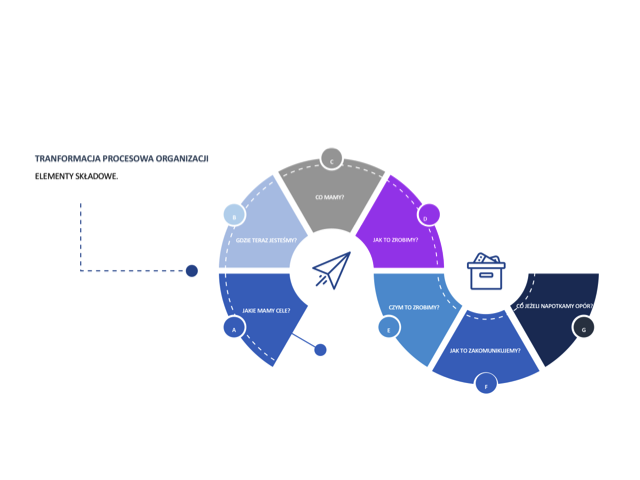Solutions supporting process transformation. 
A system of strategic goals that defines the direction in which the organization is heading.
The desired change within the organization should have a clear direction, guided by a comprehensive system of goals that align with a broader perspective. These goals should be translated into shorter-term objectives and specific actions, shaping the path for future transformation and guiding the implementation of appropriate tools. It is crucial to document these objectives in writing and effectively communicate them to all members of the organization, not just the management.Read more...
Organizational audit , specifying the starting point from which the organization goes towards changes.
To achieve the goals, it is essential to have a clear understanding of the organization's current position. This involves dividing the organization into specific areas and establishing expected values. Conducting an honest assessment is the crucial starting point. It requires evaluating where the organization currently stands and identifying the desired destination. From there, it becomes essential to determine the necessary actions that must be taken to bridge the gap between the current state and the desired future state. By addressing these questions—where do we want to be, and where are we currently?—the organization can develop a roadmap for success. Read more...
Architecture, Process Matrix - to identify processes (top down approach) and map them (bottom up approach).
The initial step towards further actions, such as optimization and improvement, is the identification of processes. Understanding the flow of processes within the organization and systematizing them in a structured manner brings about a sense of order and enhances organizational transparency. Implementing such a solution within the organization provides awareness of the interconnections between processes, their hierarchy, and often reveals the associated responsibilities. It not only clarifies process ownership but also identifies the participants involved in each process. Incorporating indicators of responsibility in the process identification helps stabilize the organizational structure and addresses challenges associated with dispersed or undefined responsibilities. Process mapping and visual representation of process flow bring clarity to employees' tasks and facilitate the standardization of activities across the organization.
Defined Strategy for process excellence.
When an organization engages in numerous activities related to process identification and optimization without a specific plan aligned with strategic goals, these efforts can be considered accidental, even if they have the potential for success. However, by developing a strategy dedicated to achieving process excellence, the organization can amplify its impact. This strategy establishes a clear link between activities and goals, defines the tools utilized throughout the process, outlines rules for collaboration with team members, and sets a trajectory for continuous improvement over time. Having a well-defined plan for achieving excellence significantly increases the likelihood of success compared to engaging in scattered and disconnected activities.
Process documentation and a plan to build the commitment of the members of the organization.
In the pursuit of process excellence, establishing robust cooperation with process owners and participants is vital. Providing them with a tool that facilitates the management of this collaboration is essential. The documentation should include elements that define process excellence, such as process identification, interconnections with other processes, optimization strategies, measurement techniques, and formalization methods. By incorporating these elements into the documentation, the organization can effectively guide and support the achievement of process excellence.
Communication plans in the process of change.
Even with the best plan and tools in place, achieving the desired results within the organization can be hindered if they are not effectively communicated and internalized by its members. Communication plays a crucial role in ensuring the proper implementation of changes and is a key factor for success in the pursuit of process excellence. It is essential to address the questions of when, how, and to whom the changes are communicated. The answers to these questions significantly impact the organization's ability to achieve process excellence. By strategically and effectively communicating changes, the organization can enhance the understanding, acceptance, and adoption of the necessary transformations, ultimately leading to success.
Plans for managing resistance in the process of change.
Change often encounters resistance, which is why it is crucial to employ mechanisms to address and manage such resistance during the change process. Implementing an effective resistance management plan is essential for the organization to successfully achieve its goals and objectives. Resistance can hinder the efficient and effective implementation of desired changes, potentially undermining the organization's progress towards process excellence. By proactively addressing resistance and having a well-developed plan in place, the organization can navigate through challenges more smoothly, facilitating the journey towards process excellence
© 2025 Anna Stusik-Kursa. All rights reserved.
